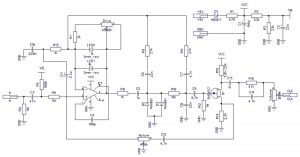
Kingbee
I’m a big fan of the low gain distortion effects. I think they are more versatile and if higher gain is needed, then they can be simply stacked. Well, maybe not the best solution for death metal, but in rock or blues I think such a configuration is much more useable. We already had an entry in this topic. This entry’s subject, the Honeybee was designed by the same Bjorn Juhl who also designed the above mentioned Sweet Honey overdrive as well. The sound is similar, though the electric design is quite different. In use the big difference is the Nature pot and how it works: similar to the Sweet Honey it does impact both the overall tone and the gain level, but here the gain increases by turning the pot more in the bass direction. The effect handles boosters well in front of it and can be used well with bass guitars too. I recommend to try it.
 The circuit is made of two big blocks: an opamp based stage is followed by a common source JFET stage. We also have soft- and hard-clipping as well. As usual one could play with these clipping diodes, but to be honest I didn’t try that, as the original arrangement sounded just perfect for me. The CA3130 is an obsolete part in the original, one could use actually any single opamp here(the good ole’ TL071 pops to my mind immediately), but then the C4 compansating cap is unnecessary and can be left off. JFETs are not too videly available anymore these days, I tried a few of them and had good results with the J202 as well. When trying different JFETs it makes sense to use a pot or trimmer in the place of R15 and only replace it with a fixed resistor once the correct value is found.
The circuit is made of two big blocks: an opamp based stage is followed by a common source JFET stage. We also have soft- and hard-clipping as well. As usual one could play with these clipping diodes, but to be honest I didn’t try that, as the original arrangement sounded just perfect for me. The CA3130 is an obsolete part in the original, one could use actually any single opamp here(the good ole’ TL071 pops to my mind immediately), but then the C4 compansating cap is unnecessary and can be left off. JFETs are not too videly available anymore these days, I tried a few of them and had good results with the J202 as well. When trying different JFETs it makes sense to use a pot or trimmer in the place of R15 and only replace it with a fixed resistor once the correct value is found.
As usual, the build docu can be found under the Projects menu.


No Comments